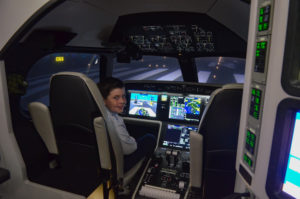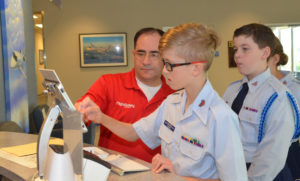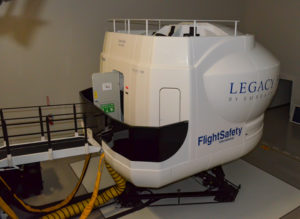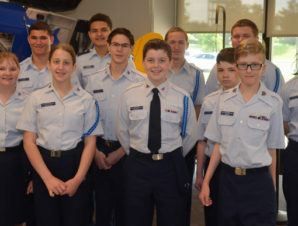Flight Safety International Tour
Product Information
 The Cadets of the Nighthawk Composite Squadron recently got a unique experience flying the Embraer Legacy 500 (E550) simulator at Flight Safety International in Fort Worth Texas. And yes, this is the full articulating motion flight simulator that you would expect from Flight Safety, although for the interest in time, the aircraft motion was turned off. For some time now, 1st Lt Nelson Hernandez of the Fort Worth Senior Squadron, has been devoting his spare time to giving cadets of local squadrons tours at his job as an aircraft simulation ground instructor
The Cadets of the Nighthawk Composite Squadron recently got a unique experience flying the Embraer Legacy 500 (E550) simulator at Flight Safety International in Fort Worth Texas. And yes, this is the full articulating motion flight simulator that you would expect from Flight Safety, although for the interest in time, the aircraft motion was turned off. For some time now, 1st Lt Nelson Hernandez of the Fort Worth Senior Squadron, has been devoting his spare time to giving cadets of local squadrons tours at his job as an aircraft simulation ground instructor
The tour / class was given to 10 cadets broken into two groups and lasted about 3 hours. It all started with a tour of the facility, then onto a training classroom where the cadets were given iPad simulators to learn some of the basics of the E550 like safety, emergency, airspeeds, transfer of controls, memorization items, and the controls for the Flight Management System (EMS). For paying customers, this portion of the training takes five days going over all aspects of the Embraer systems.
One scenario given to the cadets was if you had a fire what would you do? C/Amn Evelyn Rosenfeld said she could not find that procedure, in the emergency checklist. “We also had to memorize certain speeds, so we could land the plane” Rosenfeld added.
 Teams were further broken down to two cadets, and for this portion of the training, rank has its privileges. Senior cadets got left seat (captain and pilot-in-command), while the lower ranking cadets got the right seat (first officer and co-pilot). Nelson sat behind the cadets in the instructor’s seat acting as air traffic controller. Cadets were given a mission to take-off from JFK Airport to the Freedom Tower and return back to JFK for a visual approach. Using Crew Resource Management techniques, cadets were expected to behave like professional pilots calling out speeds, gear, flaps etc. At the Freedom Towers, transfer of controls was handed off to the co-pilot, who got a chance to fly the simulator back to JFK where transfer of controls was once again transferred back to the pilot for landing.
Teams were further broken down to two cadets, and for this portion of the training, rank has its privileges. Senior cadets got left seat (captain and pilot-in-command), while the lower ranking cadets got the right seat (first officer and co-pilot). Nelson sat behind the cadets in the instructor’s seat acting as air traffic controller. Cadets were given a mission to take-off from JFK Airport to the Freedom Tower and return back to JFK for a visual approach. Using Crew Resource Management techniques, cadets were expected to behave like professional pilots calling out speeds, gear, flaps etc. At the Freedom Towers, transfer of controls was handed off to the co-pilot, who got a chance to fly the simulator back to JFK where transfer of controls was once again transferred back to the pilot for landing.
C/AB Zachary Bettilyon, who was in the first officer position, said that he had problems reaching the pedals. “We had to memorize the controls for the autopilot, which we used for the speed. We controlled turns and up and down on our own.”
“I did the takeoff and landing”, Rosenfeld commented, “but, after I successfully landed, I went off the runway. It was my first time ever flying an aircraft. I was surprised how easy it was to fly,” she concluded.
 “I don’t want the cadets to get the red screen, meaning the airplane crashed,” Nelson says. “I want the cadets to come away with a positive experience.” For the most part, the entire flight is conducted using the autopilot. “If the cadet pilot looks confident, then I will let the crew disengage the autopilot and complete the landing.”
“I don’t want the cadets to get the red screen, meaning the airplane crashed,” Nelson says. “I want the cadets to come away with a positive experience.” For the most part, the entire flight is conducted using the autopilot. “If the cadet pilot looks confident, then I will let the crew disengage the autopilot and complete the landing.”
After being introduced to flying the E550 jet simulator, C/Amn Rosenfeld is considering joining the Air Force to fly jets, and C/AB Bettilyon would like to fly for the airlines.
“I’m amazed as to how well the cadets react to this experience” Nelson concluded. “Many of them didn’t realize how accessible aviation can be. Many leave considering a career in aviation. In fact, one cadet who had a disability learned that there are many roles in aviation that he could pursue.

